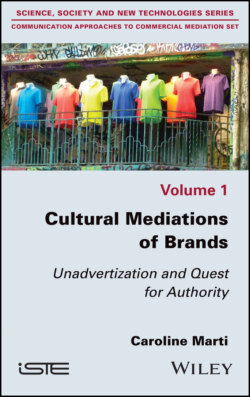Читать книгу Cultural Mediations of Brands - Caroline Marti - Страница 10
I.1.2. From cultural proposals to unadvertization and figuration
ОглавлениеThe term proposal is not very precise, but it is practical for the first approach for a phenomenon that is neither circumscribed nor homogeneous, but representative of an address to its recipient. A proposal has neither the commitment of the promise, which is the expression of a willingness to share a belief with those for whom it is intended, nor the connotation of the offer that shows its intent. This is a euphemization of a form of address to consumers, but an intense form of address to individuals seized as audiences, or users of culture. This is a question of a transformation of the traditional communication places of the interlocutors of commercial exchanges. These cultural proposals remain to be defined and this will be the challenge of the following chapters, but before entering the forest of their modalities, to specify the paths of their stakes and scope, we can give a general outline.
I first identified these cultural proposals by working on a doctoral thesis carried out at CELSA and defended in 2005 on brand magazines – magazines built to promote brands (Montety 2005). As emblematic objects of a cultural position, they seemed particularly interesting to me to question and analyze in order to identify the approaches of the project owners and the constraints of the project owners, to understand the hybridizations at work, the arbitrations necessary to develop editorial lines combining advertising requirements and informational rigor. Finally, they seemed particularly valuable to me for taking a first look at the conceptions of communication at work in these pages given to unsure reader-consumers. It is in this context of doctoral research that I have put forward the notion of “unadvertization” to designate the propensity to promote a brand, without looking like it, by distinguishing oneself from standardized advertising formats to assume the role of cultural actor.
This first experience of in-depth research was followed by many others, conducted alone and in groups, thanks to the companionship within GRIPIC4 with Karine Berthelot-Guiet and Valérie Patrin-Leclère, which collaboration resulted in the publication of a collective work (Patrin-Leclère et al. 2014), our points of view being both convergent and complementary. Indeed, our points of view converged because all three of us were very attached to ICS (information and communication sciences), shared a common dynamic, nourished by shared readings and methodologies, but also the same emotions and curiosity for contemporary changes in brands and the media. Indeed, our points of view were complementary, because our views remain singular, even on similar fields.
Valérie Patrin-Leclère, a media specialist, worked particularly on the phenomena of publicizing (that is, publicitarisation in French) devoting a combined semiotic, technical, and economic perspective to media plasticity in her relationship to advertising, while Karine Berthelot-Guiet, an advertising specialist, focused on uncovering the substantial advertising core – both substrate and social circulation – of publicizing (that is, publicitarité in French). For my part, I was absorbed in the phenomena of unadvertization, which refers to the tactics of advertisers, who aim to distinguish themselves from the most recognizable forms of advertising and replace them with forms of communication that are supposed to be more discreet5. I identified and explored media and, more generally, cultural appropriations of brands appearing as operators of these productions on their own account: brand magazines, films and brand series, museums and brand exhibitions, brand books, etc., all intended to bypass advertising as a professional qualification while focusing on advertising practice, in the second meaning of the term, referring to making something known in the public sphere (Habermas 1988). The corollary of this phenomenon is hyperpublicitarianism, with an increasingly strong presence of logos and brand attributes in cultural and social life, in areas not dedicated to brands.
This book is an extension of my work on unadvertization. It is also the continuation of an HDR, or French Habilitation6, defended in 2015 and carried out under the supervision of Yves Jeanneret.
The objective of the book is to question the propensity of brands to appropriate social forms in order to legitimize themselves in the social space and build their authority. To question forms, which are socially connoted, and the quest for authority, is to attach itself to the articulation between power and what Yves Jeanneret (2014, p. 74) calls figuration:
Figuration couples with expectation: it is the other side of the meaning of forms, on the side of the poetics of texts and media expressions. It is a representation of the communication process that does not involve an explanation, as is the case with the promise, but is based on the interplay of forms mobilized within media productions and textualities.
The cultural figurations I mention are communicative modulations around brands, semiotic entities that actors work on to make subjects of social communication.
